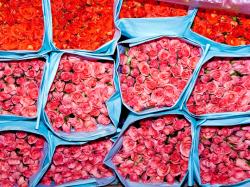It's Always Springtime At The Manhattan Flower District
March 22, 2012 | 2 min to read

March 20 may be the official first day of spring, but on West 28th Street between 6th and 7th Avenues in Manhattan, flowers are always blooming. That’s the home of the venerable old Chelsea Flower Market where wholesalers congregated in the 1890s to be near the then stylish Ladies’ Mile shopping district. In the market’s mid-20th century heyday almost 60 shops—many of them owned by generations of the same family—turned the pavement into a virtual botanic garden. There were vast banks of carnations, tightly-packed bundles of roses and tulips, tropical lilies, heliconias and ginger, along with pots, ribbons and floral decorations of every kind.
Re-zoning that allows for hotels and housing, spiraling rent and direct sale of flowers on the Internet has taken a toll on the market, forcing many shops to move to the suburbs. But reports of its demise are exaggerated, as I discovered on a morning walk through the market last week sponsored by the New York Botanical Garden‘s Continuing Education department.
The workshop, led by Maureen Laning, a graduate of the garden’s Floral Design certificate program and owner of Bedford Village Florist in Bedford, New York, met at 9 a.m. at the McDonald‘s on 6th Avenue at West 28th Street where men carrying towering ferns and massive bundles of pussy willows passed by, headed for delivery trucks double-parked in the crowded neighborhood around Penn Station. Congestion is a big problem, but apartment dwellers and pedestrians can’t complain about trash and bad smells because there’s no place more pleasing to the nose and eye than this little patch of urban garden, now home to about two dozen flower shops.
They get to work early—say, 4 or 5 a.m.—and close around noon. By then most professional designers and retail florists have come and gone, bagging the best and most unusual product, Maureen said. But mid morning is a fine time for casual flower-lovers to investigate shops like Superior Florist, founded in 1930, and G. Page, another longtime fixture at the market; Caribbean Cuts, which features exotic blossoms and succulents, now popular among designers for the texture they add to arrangements; and refrigerated Harvest Roses, which gets most of its blooms from Ecuador, increasingly one of the world’s biggest producers of cut roses, including the exquisite Malu rose bouquet I saw in the window—each blossom almost 5 inches from tip to base. (The leading cut-flower supplier to the United States? Colombia.)
To read the rest of the story, please go to: Smithsonian Magazine
